The aim of the recently concluded five-year EspLORE project was to explore the properties of carbon atomic wires in order to exploit their application potential. The project was led by Professor Carlo S. Casari from the Department of Energy, funded by a major Consolidator Grant from the European Research Council (ERC).
The work is not yet finished, because, as we will discover, EspLORE has given birth to several ‘children’, such as PROTECHT, PYPAINT and KEEPER.
To improve our understanding of these extraordinary properties of carbon nanostructures, we visited NanoLab, a laboratory researching micro- and nano-structured materials, located in the characteristic brick building that has been home to the Enrico Fermi Centre for Nuclear Research on the Leonardo Campus since 1960.
Here, we were welcomed by some of the leading EspLORE researchers: Sonia Peggiani, Anna Facibeni and Alessandro Vidale. The atmosphere in the workshop is friendly, almost family-like, so much so that we immediately adopt the informal ‘tu’ in Italian.
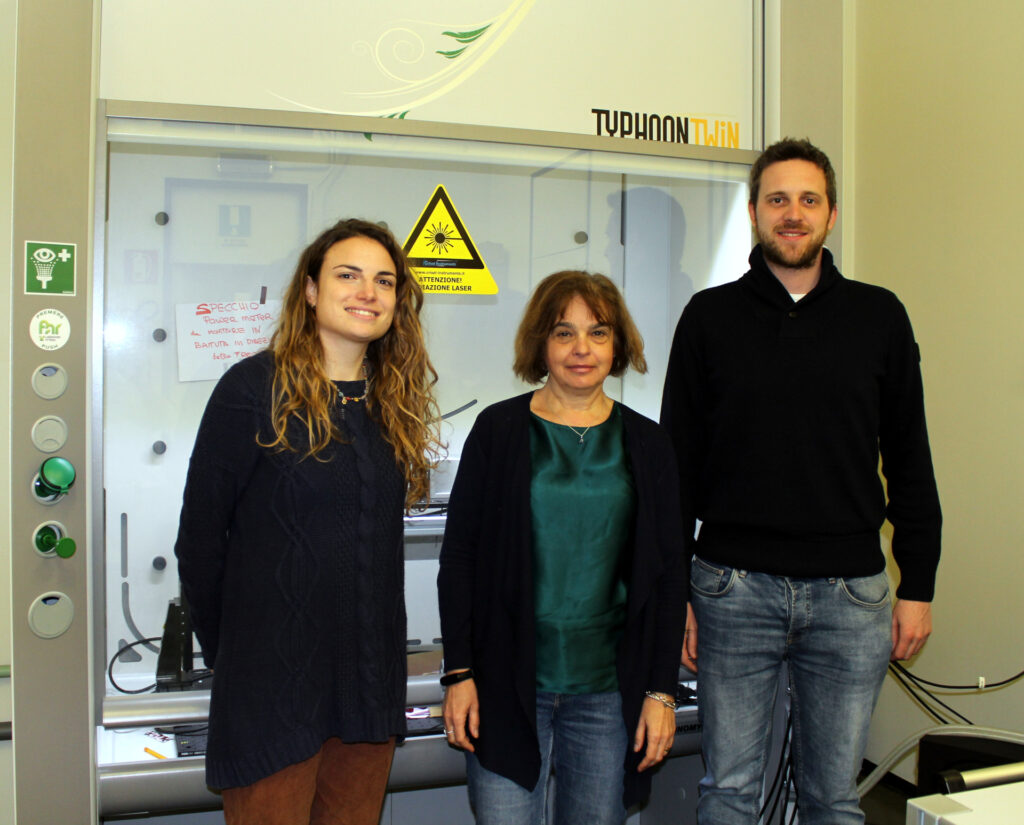
We begin with introductions. How did you end up at NanoLab?
SP: My name is Sonia Peggiani and I am a post-doc research fellow at NanoLab. I did my PhD here, which I completed in 2021 with the thesis ‘Fabrication and characterisation of atomic carbon wires and nanocomposites.’ I am currently working on the design and creation of anti-counterfeiting labels for various commercial sectors.
AF: My name is Anna Facibeni and I am a veteran of the Politecnico. In fact, I have been here for 30 years. I was brought onboard by Professor Casari from the very beginning of the project. I am a chemist, and I work on the development of materials, which are continuously increasing. I supervise chemicals and waste disposal.
AV: My name is Alessandro Vidale and I am a research fellow. I did my master’s thesis here at NanoLab, focusing on the production and characterisation of linear sp carbon chains embedded in electrospun polymer nanofibres. The project I worked on is PROTECHT, on anti-counterfeiting labels for documents, which Sonia joined when she finished her PhD, and on which we are still working on.
Project to be discussed later. Everything, however, starts with EspLORE. What is it?
SP: EspLORE was a project of basic research on carbon nanostructures, funded by an ERC Consolidator Grant for 2017-2022.
The core research was the synthesis and characterisation of sp carbon structures and hybrid sp-sp2 hybrid systems, with the aim of studying them in energy applications. For convenience, we will use the designations ‘linear carbon chains’, ‘carbon atomic wires’ and ‘1D carbon nanostructures’ synonymously.
The project consisted of three sub-activities: synthesis and characterisation of 1D nanostructures with laser in liquid and arc discharge in liquid, development of nanocomposites based on 1D nanostructures and exploration of the potential use of these materials in different applications.
My PhD, which started in 2017, was dedicated to the synthesis and characterisation of 1D carbon nanostructures.
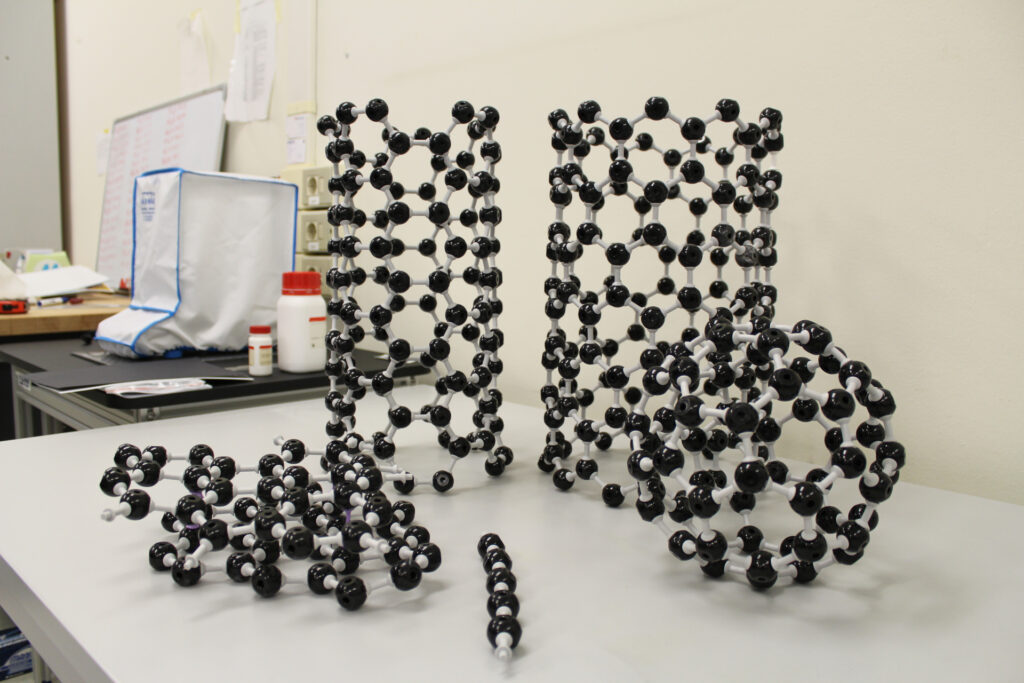
Could you explain what these carbon structures – so central to your research – are, in layman’s terms?
SP: Imagine these carbon nanostructures as wires. [saying this, she picks up what look like large construction toys for overgrown children, but are in fact models of these very structures]. The carbon atoms are positioned in a single row like pearls on a necklace.
Some studies claim that these structures originate from interstellar dust, because traces of them have been found in the chaoite (or white carbon) of a meteor.
These materials have important properties in terms of mechanical strength. They have a very high thermal conductivity, much higher than copper, which is useful for example in the design of faster transistors.
From the point of view of energy applications, they have the advantage of having a very large surface area, 20,000 times that of graphite, thanks to which they can store large quantities of hydrogen, like veritable sponges.
Let’s move on to the synthesis and characterisation of these structures. How do you do this?
AF: Here in the lab, we use two techniques: arc discharge or pulsed laser in liquid. Both are physical methods, which have their pros and cons. The virtue of physical methods is that they are clean, safe and quick. The downside is the stability of these products. These methods are much more easily scalable too.
AV: Our great achievement is that we have managed to stabilise them with polymer matrices. In my thesis, I described how to encapsulate nanowires using polymer matrix electrospinning. In this case, I used carbon nanostructures produced with a chemical process.
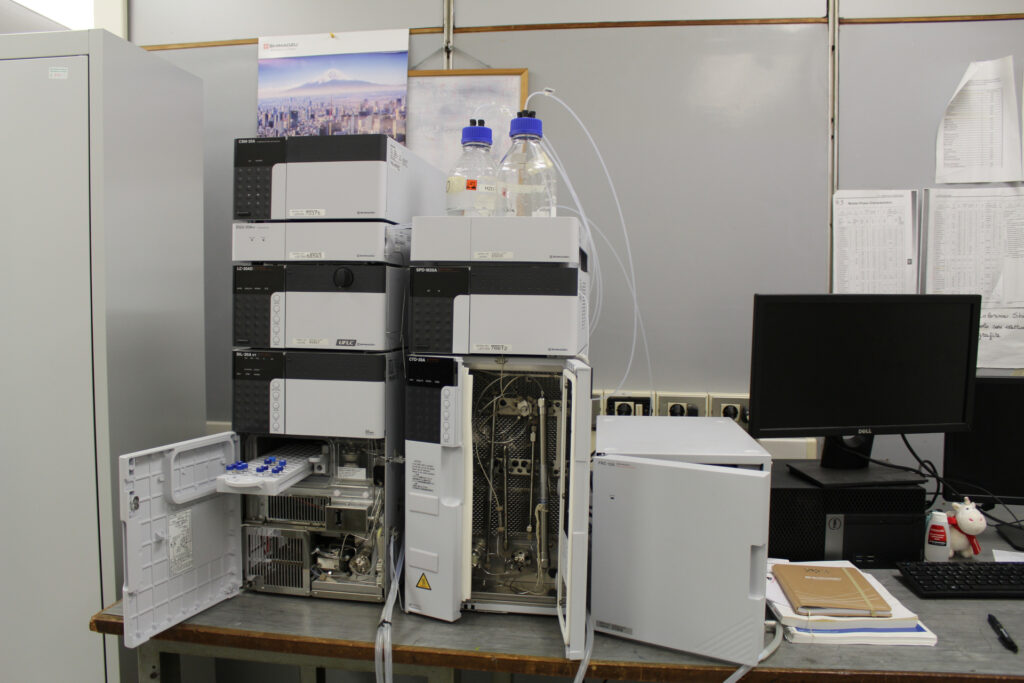
What is the physical method you use in the laboratory?
[We approach the first of the machines]
AF: We use two graphite electrodes connected to a power supply. Inside a container holding solvent, they are brought together with a certain current potential, generating a discharge. The carbon breaks down and from this process, we generate our nanostructures.
The composition of the products obtained differs depending on the solvent used. The products are purified using HPLC (high-performance liquid chromatography), widely used in analytical chemistry to separate, identify and quantify each component of a mixture.
The next stage is analysis with the spectrophotometer. With the detector, we hit the sample with a beam of light, resulting in a graph with peaks. A three-peak graph tells us that we have achieved the result, because it is typical of nanostructures. The peaks may shift depending on the length of the structure. Each spectrum is characteristic of a species that came out at a certain time: longer structures come out later, shorter ones earlier.
What are the most important results you have achieved with EspLORE?
SP: One major achievement was the publication in Nature Communications of the article ‘Electron-phonon coupling and vibrational properties of size-selected linear carbon chains by resonance Raman scattering’, whose first author is Pietro Marabotti; it was a work made possible thanks to the collaboration with Elettra Sincrotone Trieste.
In addition, we succeeded in obtaining an ERC Proof of Concept grant for the PROTECHT project.
Alexander worked on this project. What is PROTECHT?
AV: The idea was to exploit the nanostructures we produce in our laboratory for security applications and also to generate possible business opportunities. We devised an advanced anti-counterfeiting tag based on polymeric nanocomposites containing carbon nanostructures. The unique optical response of these systems enables the design of security tags: layers and fibres incorporating special codes that can be inserted into identity documents and banknotes.
The advantage of these labels is that they can be produced using low-cost production techniques and thus have strong commercial potential including for implementation in low-income countries.
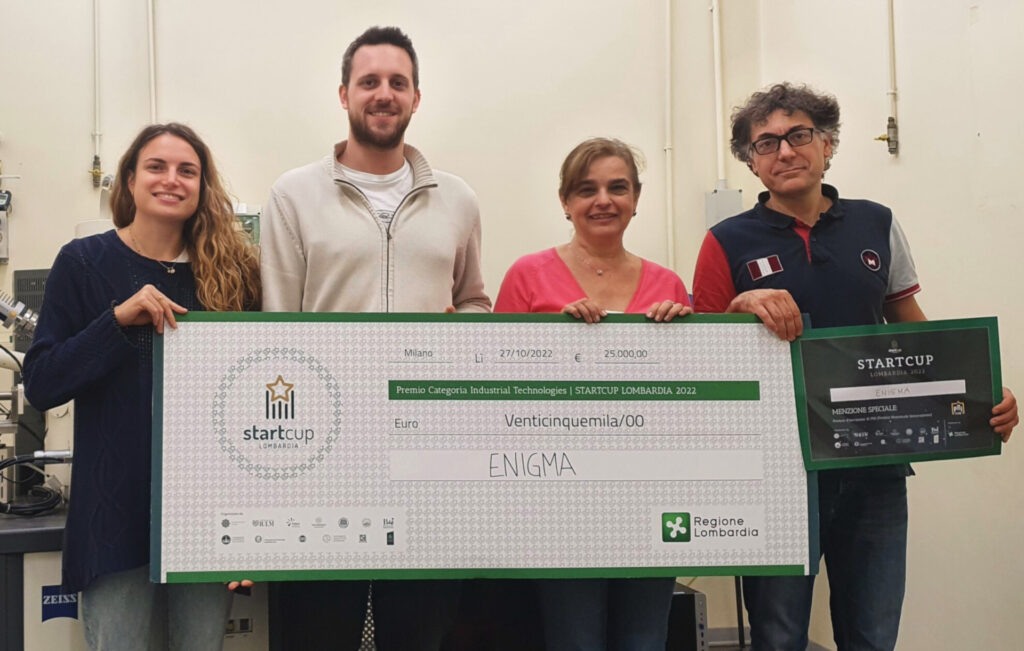
And the development of these new tags led to the awards.
AV: Yes, in 2021 we won Switch2Product, the innovation challenge organised by PoliHub, with the ENIGMA project, a continuation of the activity of PROTECHT’s activities, presenting the prototype of an anti-counterfeiting label.
Then, in 2022, we won the Startcup Lombardia and the and the participation in the 20th edition of the Premio Nazionale dell’Innovazione (National Innovation Award), winning the LIFTT special prize, thanks to which we had the opportunity to interact with the LIFTT investment fund.
Switch2Product was a leap forward. What changes going from the laboratory to the market?
SP: The S2P award is an important path of acceleration with PoliHub. Preparing business plans, doing market analysis was a whole new world for us. It was a very challenging transition, but at the same time very stimulating, because you get to know many realities, you get to know the investors.
AV: We had so many meetings in very different market sectors, because anti-counterfeiting is applicable to everything, as long as it is of high value. We met artists, wine producers, luxury companies, drug manufacturers, the Mint, the Bank of Italy, the forensic scientists, the food industry, manufacturers of industrial parts, cars, switches.
We will now set up the start-up by June, and we requested to get accreditation to be a Politecnico spin-off. We mainly focused on two markets, works of art and documents: all very high-value goods.
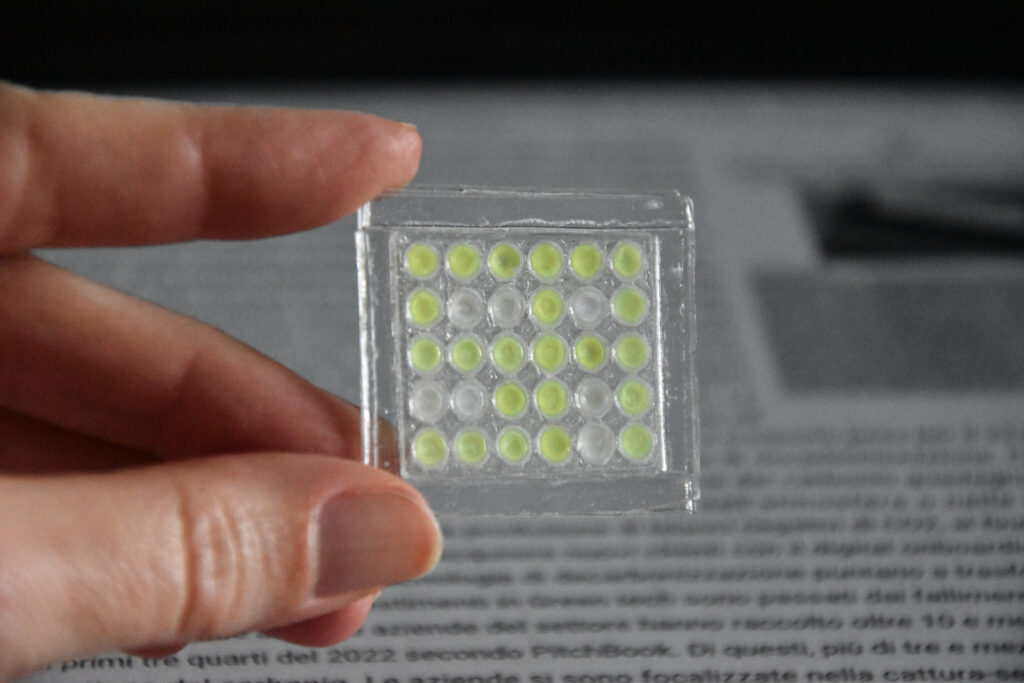
The artwork part of the project continues with PYPAINT. What does this focus on?
AV: After the grant agreement, we launched the 18-month PYPAINT (Protect Your Peerless Artwork with Innovative Nanoengineered Technology) project on 1 March. The project is devoted exclusively to works of art We will be meeting the artist Sgolpe with the Swiss gallery Valuart. The dream would be to put it on canvas for display.
This project continues with the development of a printable anti-counterfeiting system based on our carbon-based nanostructures with a specific optoelectronic response. These create a unique artwork identification code, invisible to the human eye. It is precisely the invisibility of the inks that means you can print them on a transparent label or even directly on the artwork. We can trace unique patterns made up of dots, which can make up almost infinite combinations, in the order of 1025.
The patterns can then be read by special optical readers. Verification requires logging in to a remote database, using a multi-layered security protocol, to guarantee not only the authenticity of the work, but also its history and its relationship with the artist’s other works, creating a reliable digital medium for the owner as well.
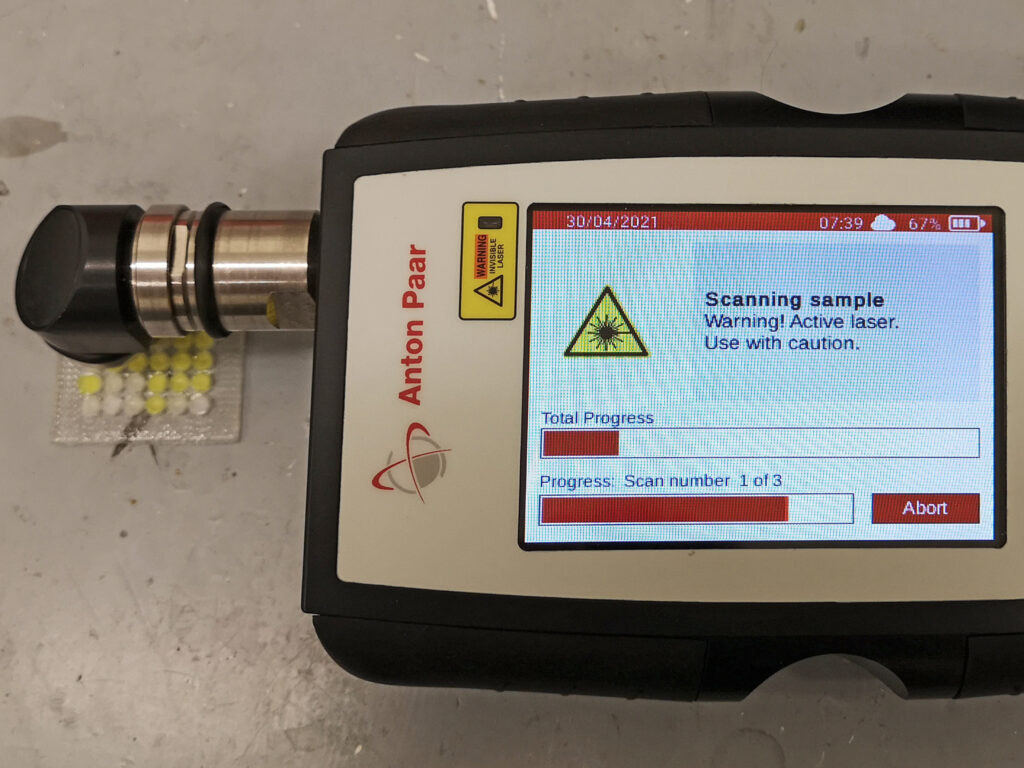
Tell me instead about KEEPER, another EspLORE-derived project.
SP: It is a €2.1 million, 30-month project financed by several partners: Politecnico di Milano, Gdańsk University of Technology, DayOne, Varius Card (an Austrian company that produces plastic cards). The goal is to expand our project from the laboratory to the level of industrial importance.
The acronym KEEPER stands for ‘Key codE based on nanomatErials to Protect sErvices and pRoducts’. The project focuses on the problem of counterfeiting sensitive documents, such as stamps and other values.
It combines the two resources we have been working on for the past few years: nano-engineered inks to be used on documents or packaging (3Tag) and the verification technique via special reader (3Check). The big advantage is that the very specific nature, the coding sequence and the reading method make KEEPER technology extremely difficult or almost impossible to replicate by reverse engineering.
In July 2022, the Politecnico di Milano filed a patent application on this product.
If you are curious to know the story of Sonia Peggiani’s personal and professional career as a researcher, read her interview on Frontiere.
